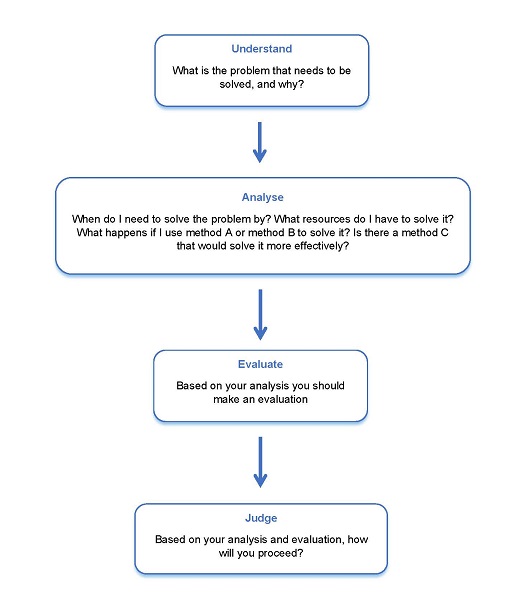2.1 What is critical thinking?
Critical thinking is a form of making a judgement; it is not about being negative. It is something that most people do, daily, often with little awareness of the process they are going through. In simple terms, an example of everyday critical thinking is, I’m going hiking today, should I wear trainers or sandals? Critical thinking involves making an assessment of something, and then providing a critique of that position and putting forward new positions. For example, flip flops may be comfortable for the first part of the hike, in hot weather. However, the top of the mountain is rocky so a more substantial trainer might be needed to get to the summit and protect your toes.

There are different stages to critical thinking, but they follow broadly similar steps. Firstly, you need to understand the issue at hand and the problem that is being faced or needs to be solved, and why? Secondly, it is necessary to carry out some form of analysis or collect some evidence about possible ways to understand the issue. For example, when do I need to solve the problem by? What resources do I have available to solve it? What happens if I use method A or method B to solve it? Is there a method C that would solve it more effectively? Thirdly, on the basis of the analysis, an evaluation is carried out, and finally a judgement is made about which way to progress. The advantages of working through these steps is that it widens thinking about a situation or issue, and opens up opportunities to different possible outcomes and solutions.
Elder and Paul (2012) describe a ‘well cultivated critical thinker’ as someone who:
- raises vital questions and problems, formulating them clearly and precisely
- gathers and assesses relevant information, using abstract ideas to interpret it effectively
- comes to well-reasoned conclusions and solutions, testing them against relevant criteria and standards
- thinks open-mindedly within alternative systems of thought, recognising and assessing, as need be, their assumptions, implications, and practical consequences; and
- communicates effectively with others in figuring out solutions to complex problems.
Why is critical thinking important to psychology and research methods?
Critical thinking enables the researcher to go through the process of recognising their assumptions, challenging them and looking at possible other ways to do something.
In applying critical thinking to research, you will understand that there are different types of research questions; and that these different types of questions require different types of research designs (and consequently different methods) to answer them. If the question and the design do not correspond, then the conclusions that are made about the research are likely to be questionable at best, and probably wrong.
Now you have a better understanding of what critical thinking is, you will move onto look at a framework for developing research questions.

